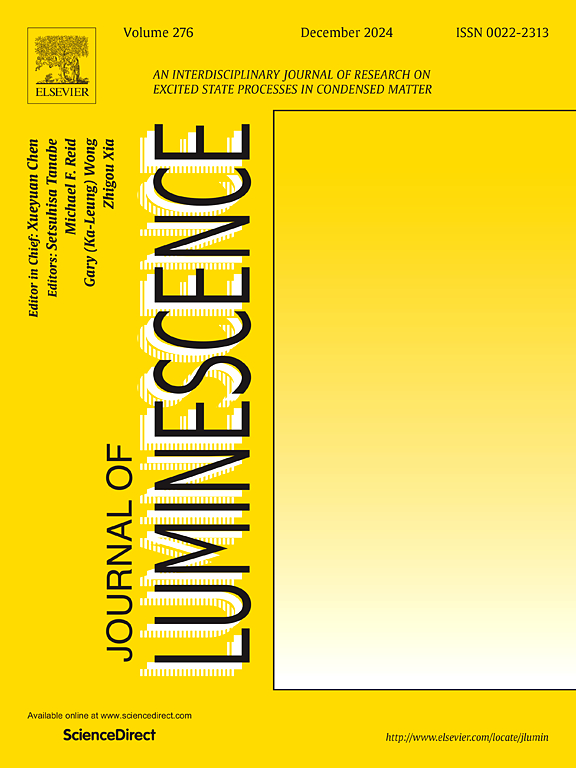Y3+对热压Eu2+掺杂CaF2透明陶瓷微观结构和闪烁性能的影响
IF 3.3
3区 物理与天体物理
Q2 OPTICS
引用次数: 0
摘要
通过共沉淀法合成纳米颗粒,在惰性气氛下采用热压烧结法制备了掺杂和不掺杂Y3+的CaF2:Eu2+透明陶瓷。共掺杂Y3+后,纳米颗粒的粒径没有明显变化,但陶瓷的晶粒尺寸明显减小。CaF2:Eu2+, Y3+陶瓷在425 nm的光透射率约为46.3%,超过了CaF2:Eu2+陶瓷。Y3+共掺杂后,Eu2+:CaF2陶瓷的光致发光(PL)和x射线诱导发射光谱显示,422 nm处Eu2+离子的5d-4f跃迁产生了较强的发射带,而550-650 nm处Eu3+离子的4f-4f跃迁产生了较弱的发射峰。此外,还研究了共掺杂Y3+离子对样品的闪烁衰减寿命、脉冲高度光谱和热释光的影响。本文章由计算机程序翻译,如有差异,请以英文原文为准。
The effect of Y3+ on microstructure and scintillation properties of hot-pressed Eu2+ doped CaF2 transparent ceramics
CaF2:Eu2+ transparent ceramics with and without Y3+ doping were fabricated by the hot-pressed sintering method under the inert atmosphere via the co-precipitation-synthesized nanoparticles. After the co-doping of Y3+, there was no significant change in the particle size of the nanoparticles, but the grain size of the ceramics was markedly reduced. The optical transmission of CaF2: Eu2+, Y3+ ceramics at 425 nm achieved approximately 46.3 %, surpassing that of CaF2:Eu2+ ceramics. With Y3+ ions co-doping, the photoluminescence (PL) and X-ray induced emission spectra displayed stronger emission bands at 422 nm ascribed to 5d-4f transitions of Eu2+ ions and weaker emission peaks at 550–650 nm range originating from 4f-4f transitions of Eu3+ ions in Eu2+:CaF2 ceramic. Furthermore, the effect of co-doped Y3+ ions on the scintillation decay lifetime, pulse height spectra, and thermoluminescence of the samples were investigated.
求助全文
通过发布文献求助,成功后即可免费获取论文全文。
去求助
来源期刊

Journal of Luminescence
物理-光学
CiteScore
6.70
自引率
13.90%
发文量
850
审稿时长
3.8 months
期刊介绍:
The purpose of the Journal of Luminescence is to provide a means of communication between scientists in different disciplines who share a common interest in the electronic excited states of molecular, ionic and covalent systems, whether crystalline, amorphous, or liquid.
We invite original papers and reviews on such subjects as: exciton and polariton dynamics, dynamics of localized excited states, energy and charge transport in ordered and disordered systems, radiative and non-radiative recombination, relaxation processes, vibronic interactions in electronic excited states, photochemistry in condensed systems, excited state resonance, double resonance, spin dynamics, selective excitation spectroscopy, hole burning, coherent processes in excited states, (e.g. coherent optical transients, photon echoes, transient gratings), multiphoton processes, optical bistability, photochromism, and new techniques for the study of excited states. This list is not intended to be exhaustive. Papers in the traditional areas of optical spectroscopy (absorption, MCD, luminescence, Raman scattering) are welcome. Papers on applications (phosphors, scintillators, electro- and cathodo-luminescence, radiography, bioimaging, solar energy, energy conversion, etc.) are also welcome if they present results of scientific, rather than only technological interest. However, papers containing purely theoretical results, not related to phenomena in the excited states, as well as papers using luminescence spectroscopy to perform routine analytical chemistry or biochemistry procedures, are outside the scope of the journal. Some exceptions will be possible at the discretion of the editors.
 求助内容:
求助内容: 应助结果提醒方式:
应助结果提醒方式:


